► New S-Class, new rules?
► S500 takes on German rivals
► What tops the luxe saloon class?
If the petrol limo is heading for the rocks, nobody told Mercedes. The new S-Class meets its Audi, Porsche and BMW rivals.
Mercedes S-Class: pre-flight briefing
Why is it here?
The S-Class has for decades defined the luxury saloon for all but Bentley and Rolls-Royce die-hards, and its new seventh generation moves the game on with its balance of driver-friendly dynamics, passenger opulence and tech overload for all.
Any clever stuff?
Mercedes continues to find ways of anticipating problems and assisting the driver as much or as little as required, without dimming the pleasure of helming such a fine waft-wagon, with the latest versions of all-wheel drive and all-wheel steer seamlessly integrated. And the second-gen MBUX now involves five screens…
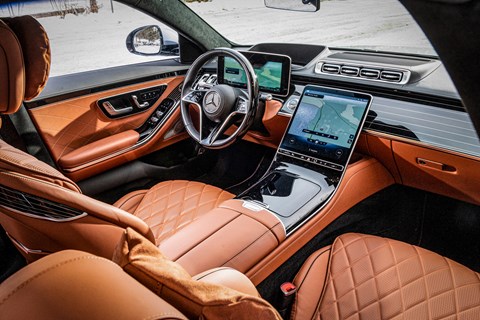
Which version is this?
There are two 3.0-litre diesel sixes and two 3.0-litre petrol sixes. This is the more powerful petrol. Everything comes with a nine-speed auto, and all bar the less powerful diesel have 4Matic all-wheel drive. Spec starts with AMG Line – really, it’s plenty – which can be suffixed with Premium, Premium Executive, Premium Plus or Premium Plus Executive. The smarter buyer sticks with AMG Line and buys a couple of option packs, so you don’t pay for more massage functions than you really want.
Porsche Panamera: pre-flight briefing
Why is it here?
Because a luxury saloon doesn’t need to look like a posh taxi. Porsche’s family car – with us since 2010, and now in its second generation – may have been overshadowed by Porsche’s own SUVs and the electric Taycan, but there’s still a huge appeal in its four-seat-911 ethos.
Any clever stuff?
Compared to the rivals here, no. The relatively unshowy Panamera is focused on executing the basics brilliantly. That includes a 2.9-litre petrol V6 that may share some elements with Audi but has become Porsche’s own; it’s a marvel of engagement and efficiency. And hats off to the £6707 optional carbon-ceramic brakes, which deliver – again and again – with usable power, in all weathers, without fade.
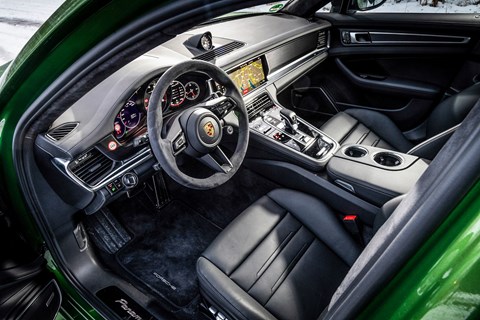
Which version is this?
Considering it’s not a huge seller, the range is ridiculously big. Body wise, you have this Sports Saloon (actually a hatch) or the Sport Turismo (sort-of estate). Rear- or all-wheel drive, turbo or hybrid, six or eight cylinders, and very fast or extremely fast. Our 4S is roughly in the middle of the Panamera range, although it’s one of the most expensive cars in this group of rivals.
BMW 7-Series: pre-flight briefing
Why is it here?
Traditionally the more driver-focused alternative to the S-Class, although that contest has always been quite spec-dependent. The current 7-series (the sixth generation, but facelifted in 2019) is low-key to the point of anonymity, leaving the vulgar spec to BMW’s booming big SUVs.
Any clever stuff?
It’s the only plug-in hybrid in this group (although not the only one available), which adds a 111bhp electric motor to the 282bhp six. On the road, transition between the two is smooth and effective. But it’s a set-up that doesn’t make sense for everyone. On long journeys, you’ll run out of charge and end up carrying a heavy battery in an already heavy car with a relatively modest petrol engine, and the fuel tank is down from 78 to 46 litres. BMW claims 4.4 hours for a full charge from a wallbox.
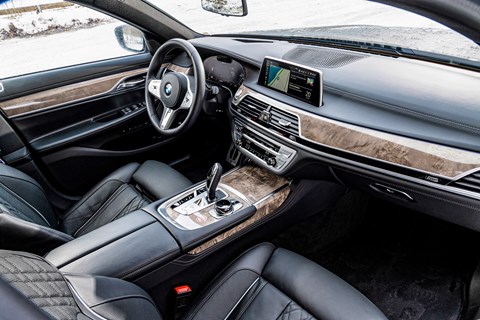
Which version is this?
It’s available as diesel (choice of two) or petrol (choice of two, plus the hybrid), regular or long-wheelbase and rear- or all-wheel drive. There’s entry trim (not shabby), then Sport, then our M Sport. The best-value way to get extra kit is with the packs, tailored to your priorities (driving, or rear-seat entertainment).
Audi A8: pre-flight briefing
Why is it here?
Through its four generations the A8 has provided the slightly sharper, more modern, less wood ‘n’ leather alternative to the Merc and BMW (and the Lexus LS). The cabin in particular was right from the start, although the infotainment has evolved into a screen-based system that, for some, is too clever by half. The A8’s never been as dynamically sharp as you would hope.
Any clever stuff?
Nothing but clever stuff. In particular the predictive active suspension, which uses a lot of science to ease you on your way. The air suspension gains electromechanical actuators that respond to inputs from road-scanning sensors, anticipating poor surfaces and adjusting for cambers.
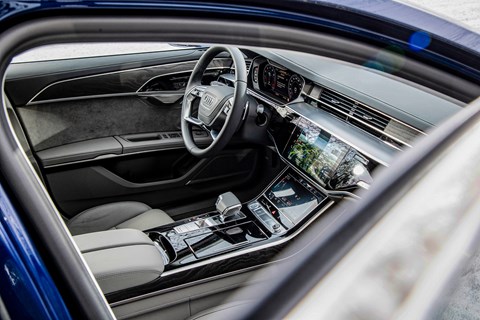
Which version is this?
The 55 TFSI in Sport trim, with a relatively modest amount of extras. Plenty more extras are available, although for many the key to the Audi’s appeal is its lack of unnecessary ornamentation. It’s available with regular and long wheelbase, with 3.0-litre petrol or diesel, a 3.0-litre hybrid, plus the 4.0-litre V8 S8. Spec levels go from Sport to S Line to Black Edition to super-pricey Vorsprung.
And the ship sails on
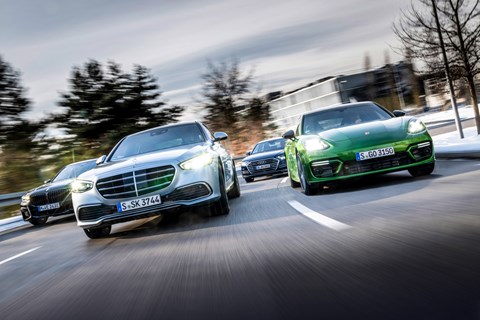
Don’t be so fast as to declare these ‘last chance’ saloons. It’s hardly the body style of the moment, and their engines are far less electrified than the zeitgeist demands, and you may well question why anyone actually needs a luxury saloon right now; exactly what business meetings are these executives in such a hurry to attend?
Yet here we have an entirely new Mercedes-Benz S-Class with a packed field of opponents: direct rivals from BMW and Audi, and a sportier alternative from Porsche. And that leaves no room for the Maserati Quattroporte and Lexus LS. The electric successors are starting to arrive, with plenty more on the way, but there’s clearly still life in this exclusive and very traditional part of the market.
At launch time the new S-Class is only available with a couple of diesels and two versions of the 3.0-litre straight-six. We’ve picked the more potent 429bhp petrol hooked up to a nine-speed automatic and all-wheel drive. In terms of power output, the big Benz competes on paper with the Porsche Panamera 4S fitted with the 435bhp variant of Zuffenhausen’s own 2.9-litre V6. The only horse with a saddlecloth marked PHEV in this upper-stratum corral is the BMW 745e, which combines a straight-six with a single e-motor for a combined total of 389bhp. We had asked Audi to provide a matching A8 60 TFSI, but since there wasn’t one available at the right time the only other six-cylinder option was the 55 TFSI, dishing up 335bhp, which in this context – if few others – can seem a little undernourished.
The 7-series, Panamera and A8 ranges start around £70k, and the S-Class from just under £80k, but a brief glance at our spec tables shows how easy it is to turn any of them into six-figure purchases (or four-figure monthly PCP payments). We’ve tried not to get too distracted by options and gadgets and luxurious adornments, although there’s no denying that part of the appeal of the S-Class in particular is the innovation in its technology, whether that be for pampering the passengers or thrilling the driver.
The presence of the Porsche – in some ways its polar opposite – brings into focus the question of what exactly we mean by luxury car. Is there some sort of golden ratio – perhaps four-fifths cushiness and one-fifth dynamism? It’ll be interesting to discover whether the Porsche’s differences feel like advantages or handicaps.
And the choice of a hybrid BMW means we can’t ignore questions of fuel consumption and emissions. But mostly we’ll be using the classic test of a luxury saloon: how fresh do you feel – how ready to make a million-dollar business deal – at the end of a long, fast journey? Not that every trip in a luxury saloon will be long and fast – some will be pootling a few miles across town – but it needs to be able to take that in its stride.
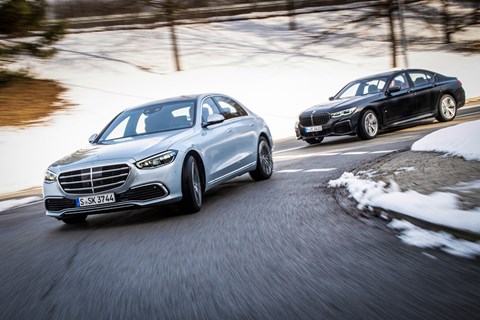
Mercedes first. The new S-Class aims to eclipse its category-defining predecessor by a substantial margin in all relevant departments while simultaneously destroying the competition. Ambitious? Proudly so. And it commences this mission by rewriting the rulebook on in-car comfort.
True comfort is not just a matter of good seats – it must stem from the car’s willingness to be driven smoothly and rapidly. To this end, the Merc has the most advanced rear-wheel steering ever, which adds a touch of magic to the term manoeuvrability. But, yes, it does also have the world’s most sophisticated seats, which create – together with the most elaborate sound-deadening efforts – a truly splendid isolation from the vagaries of terra firma and the mundane working noises of a motor car.
It aims to make the passengers feel truly special, through elegant design, well thought through ergonomics and advanced connectivity. Capable of reading lips, eyes and gestures, the S-Class provides a very special user experience indeed. It offers exclusive access to a realm between gliding and floating.
During our three days of testing, all five experts were keen to check out whether the laurels awarded in advance were justified. All approached the conservatively styled Mercedes with their sceptical heads on – surely, we all thought, it can’t be as good as the hype says it is? But none of us stepped away disappointed. Fact is, those with exceptionally skilful digits and a penchant for anything digital couldn’t be stopped from exploring the high-end MBUX entertainment system, the augmented-reality head-up display and the multi-talented Energizing packs, which don’t just offer a choice of massage functions, they also co-ordinate sound, temperature, lighting and even smells in tune with your mood and requirements.
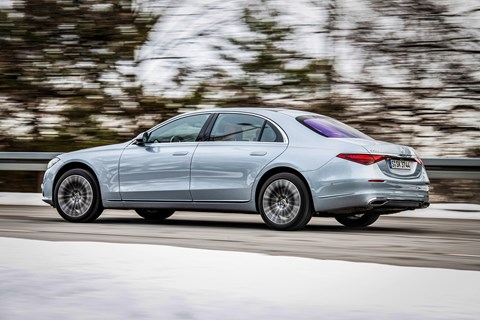
At the end of day one, two key Merc strengths emerged: an omni-present sophistication on all fronts, and the mind-boggling manoeuvrability in confined spaces.
The cosseting ride is a blend of many elements. Even the tyres are lined with a Bentley Mulsanne-style low-noise foam, the standard air suspension suppresses most irritations with suave nonchalance, and those amazing seats put an enchanting layer of insulation between man and machine.
Having said that, the low-speed ride could be a little more supple still, and the body movements on undulating turf tackled at speed could be half an amplitude less emphatic. Both issues will be attended to by the optional active suspension available later in the year. It taps 20 sensors, stereo cameras and one hydraulic actuator per wheel to eliminate excessive yaw, rebound, pitch and roll. It’s likely to be well worth the wait and the extra outlay.
There is one area where the S-Class does not beat the opposition, and that area can be found under the bonnet of the S500, where the six is irritatingly unrefined; you’d do well to explore other engine options. But that’s pretty much it for negatives.
The Audi A8 is similarly short of serious minus points, but nor does it stand tall in enough ways. It’s highly competent at many things, and has always been a class act, so any imperfections stand out. For instance, there is work required to squash the occasionally irritating noise level (wipers, tyres, engine, wind). Furthermore, the A8’s personality seemed slightly unclear to most of our testers, hovering between super-sized all-rounder and a sport-luxury cocoon.
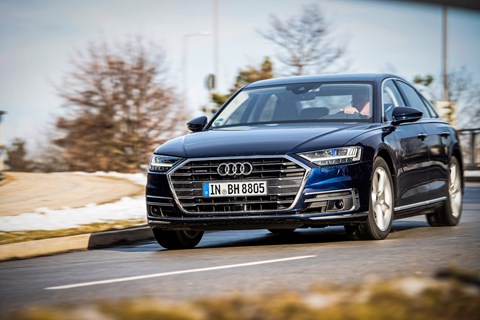
Its new predictive active suspension – which adds a Comfort Plus mode – is excellent. It keeps the body virtually level irrespective of g-force and steering action, and swiftly does away with any hint of handling waywardness. It’s this wizard chassis that puts the A8 back into contention.
What about the BMW? Just as the A8 is in essence a larger and pricier A6, the 7-series is in a nutshell a bigger and bolder 5-series available with a few more mod cons. Quite frankly, that’s not enough for either car to cut it against the Mercedes or, when different priorities matter, the Porsche.
According to BMW, the 745e averages 122.8mpg, and that’s no typo. To come even close to this planet-saving number, the 10kWh battery must be fully charged and the accelerator should only be depressed hard when absolutely necessary. But it can be done, even if the observed zero-emission range was closer to 21 than to the claimed 31 miles. The welcome geofencing function switches off the combustion engine as soon as the vehicle enters a clean-air zone. As long as the driver exercises due charging discipline and the car is primarily used for commuter and intra-city trips, the PHEV concept does have its merits.
The one dynamic downside concerns the difference in power and grunt between an empty and a fully charged battery. Minus its e-motor, the 745 makes 282bhp. In most situations that’s plenty – and the straight-six is sweeter than the Porsche and Audi V6s. But use it hard and you’ll soon experience an old-fashioned form of range anxiety, as the fuel tank of the 745e was reduced from 78 to a paltry 46 litres to make room for the battery.
The strong-voiced Porsche wins the performance trophy hands down. It’s not just the figures, although they do tell a big chunk of the story: Panamera 4.3sec, 183mph; Benz 4.9sec, 155mph; BMW 5.1sec, 155mph; and the Audi 5.7sec, 155mph.
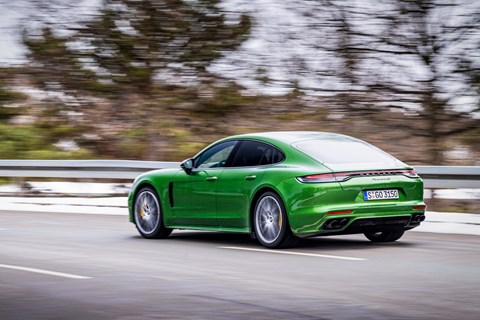
Against the stopwatch, the quartet is quite close together, but in real life it is imperative to dial in the sportiest engine-transmission setting to make these behemoths fly. And fly they will: the gruff and knotty Panamera setting the pace, the A8 relatively close behind, the 7-series heavy but still quick, the S500 perfectly capable of keeping up with the gang despite more pronounced body motions through corners, under hard braking and full acceleration.
The Panamera targets a clearly defined group of buyers who are more interested in their new purchase’s Porscheness than in traditional super-saloon properties. The ride is okay on smooth surfaces but deteriorates at low speed, on broken-up tarmac and over any transverse irritation, be it a minor expansion joint or a series of speed bumps. This muscular and sinewy set-up may deter some, and yet it is of course totally in sync with the quick and precise steering, the optional carbon-ceramic brakes which spoon out your brain under hard use, and the lightning-quick throttle-to-engine-to-transmission chain of command.
The 4S consciously avoids classic premium-segment traps like contourless lounge seats, a cabin ambience reminiscent of a hermetically sealed box and variable compliance built into steering and brakes. As a sporty five-door GT – as a Porsche – the Panamera will have none of that. The driver can push a few buttons to emphasise verve or relaxation, but the area beyond this narrow genetic framework is off-limits.
When you feel like swinging the whip in a car weighing over two tonnes, potent brakes are of the essence. In this respect, only the Porsche deserves the top score, especially with our test car’s carbon-ceramic rotors which seem to be even less immune now to cold and rainy weather. It can brake substantially later, harder and more consistently than its playmates, if need be again and again. The Audi follows in the slipstream of the Panamera with the second-best stoppers and the second-best – if mildly artificial – steering.
In this context it’s worth noting that all participants were equipped with rear-wheel-steering systems, but only the Merc can provide an extreme steering angle of up to 10º, which reduces the turning circle by a substantial 6.5ft – it feels like spinning on a dime compared with the others. Audi (Dynamic All-Wheel Steering), BMW (Integral Active Steering) and Porsche (Rear-Wheel Steering) have all gone for less extreme set-ups for a shorter virtual wheelbase effect when parking, and the illusion of an extended wheelbase for high-speed stability. For some reason, the tested 745e nonetheless displayed a certain directional ambiguity on the autobahn, not helped by the relatively nervous steering and random mild suspension excitations all-round.
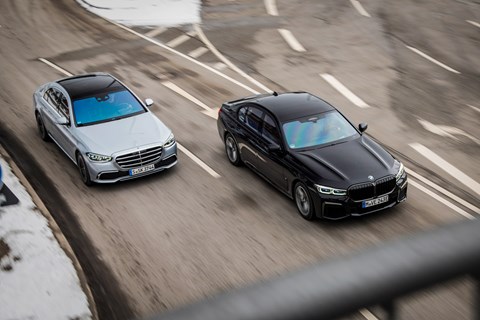
Having the Porsche here is good for highlighting the dynamic limitations of the others. Like the Macan and Cayenne, the Panamera competes on a playing field that is relatively new to the brand, but it does so on Cayman and 911 terms. The Panamera is, in other words a perfectly practical if somewhat bloated sports car, a family man’s excuse to remain loyal to the marque until the kids go to college, and a cunningly positioned alternative to all these SUVs. It’s a big car, but not vastly roomy inside.
The 4S epitomises alternative luxury by replacing classic full-size saloon values with a dozen variations of sportiness. Although there is a long-wheelbase Executive version for those who require more rear leg- and headroom, more sheet metal does not buy a more compliant ride, more comfortable seats or more up-market street cred. No, the Panamera is first and foremost a Porsche, and we wouldn’t have it any other way.
Driving dynamics aside, the cabins must be the biggest factor in these cars’ appeal. There are pros and cons across the board. Even the freshly minted Merc feels dated in places – evidence of the German manufacturers’ constant struggle to integrate smartphone-driven innovations. The oddball BMW instruments can seem like a declaration of form following cluelessness, while Porsche’s complex Innodrive feature seems designed to test your intelligence; it’s a big part of a Porsche’s appeal that it feels like a driver’s car, so a simpler interface would be welcome in the Panamera. Even the 3D display that Mercedes is offering in the S-Class looks like a miniature proscenium stage viewed through a kaleidoscope. The cabin of the Audi is nicer to the touch and kinder to the eye, but the graphics of the Virtual Cockpit and the two stacked touchscreens have not aged well.

Full praise to the 745e for retaining the familiar iDrive controller which lets the driver use one hand to do the peripheral work while eyes and mind can focus on the road. In the Audi and the Porsche, one must fumble-touch and circa-swipe one’s way through fast-fudging displays.
How about voice control? It can start a massage session or change the radio station, but it refuses to deactivate ESP, set the distance margin of the active cruise control system or switch on the sidelights. While nothing will stop the invasion of touch buttons, multi-functional touch-sliders and cheeky iris scanners, the stress on users happier in the analogue past can at least be reduced by summoning leave-me-alone black panel graphics.
Don’t get me wrong – after a relatively short adaptation phase, all these MMI systems are manageable. But when you’ve paid handsomely for a clever, luxurious car, you want to feel like you’re in charge.
Final reckoning
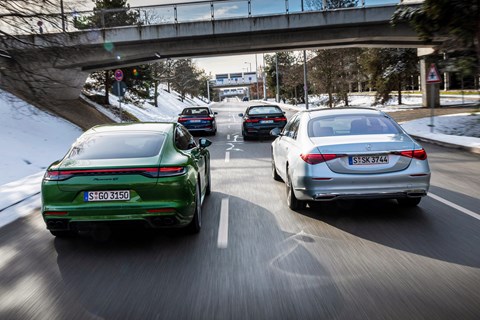
The Mercedes in the clear winner. It’s far from perfect, but does a lot of things exceptionally well. If you want a luxury saloon like an S-Class, get an S-Class.
That’s roughly what we expected to find when we started the test, but as the three days went on and the miles mounted up, the ranking was less clear-cut than expected. How come? Because in addition to plenty of hard facts, variables like attitude, personal preference, the effect of brand image and design, character, ergonomics and the man-machine interaction also entered the equation. These are complex cars and they all demand a complex, nuanced response.
And that’s why the Panamera rates second. The Porsche is playing a slightly different game; it’s not failing to be as good as the S-Class, because it’s not trying to be like an S-Class. Rather, it’s appealing to a small sub-set of luxury saloon buyers who put much more emphasis on performance than comfort and passenger-friendliness. It’s a sports car dressed up as a five-door coupe, and it is dynamically the best here, while also being able to go a long way towards satisfying the luxury saloon buyer.
The Audi and the BMW have much to commend them. The A8 is a fast and fuss-free cocoon, while this particular 7-series offers a green solution that will work well for some while not challenging for overall victory. Unlike the Porsche, they both very much are trying to woo core S-Class buyers, but on the whole neither the 7-series nor the A8 is quite special enough to vie for the top spot. In long-wheelbase form and with that zig-zag rear steering, this relatively humble six-cylinder S-Class is the current car to beat, albeit with some reservations. But it’s hard to see any version – any combination of trim and powertrain – being special enough to match the Merc.
The plug-in hybrid version of the S-Class has huge promise. But before long it may well be that the market has moved on. Mercedes has already shown what it’s planning with the all-electric EQS, Porsche has its Taycan, Jaguar – traditionally strong in this class, is currently absent – and its planned replacement for the XJ has been canned. And for some, Tesla already has the answer with the Model S.
But let’s not get ahead of ourselves. Right here we have four fine cars, one of which is a quite remarkable continuation of an unrivalled heritage.
Mercedes S-Class vs rivals: the verdict
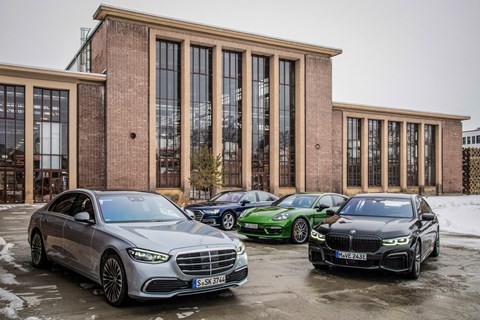
First place
Mercedes S500
The epitome of luxury, with cleverly integrated technology and ingenious steering.
Second place
Porsche Panamera
Raw performance and second-to-none driver involvement, but ride and refinement are wide of the mark.
Equal third place
BMW 745e
Good intentions, but the e-range is too limited for this to make perfect sense. Not as sporty or as refined as you’d hope.
Equal third place
Audi A8
A8 ticks all the right boxes, yet doesn’t quite equal the sum of its parts. Too synthetic and cold to be cool.